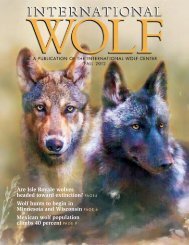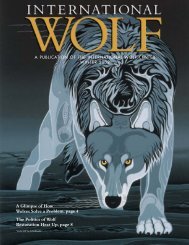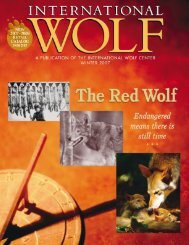a publication of the international wolf center spring 2007
a publication of the international wolf center spring 2007
a publication of the international wolf center spring 2007
You also want an ePaper? Increase the reach of your titles
YUMPU automatically turns print PDFs into web optimized ePapers that Google loves.
In Belarus, a nation slightly smaller<br />
than Kansas, large tracts <strong>of</strong> extended<br />
woodlands and forests remain intact.<br />
Census studies conducted in recent<br />
years during <strong>the</strong> early winter estimate<br />
<strong>the</strong> Belarus <strong>wolf</strong> population to be<br />
between 1,500 and 2,000 individuals.<br />
example, <strong>the</strong> study revealed<br />
that wolves consumed wild<br />
ungulates when <strong>the</strong>se animals<br />
were numerous. However,<br />
in years when wild ungulate numbers<br />
were low, wolves preyed on mediumand<br />
small-sized wild animals, such<br />
as beavers, and on domestic livestock.<br />
The rate <strong>of</strong> <strong>wolf</strong> depredation on<br />
domestic animals and <strong>the</strong> appearance<br />
<strong>of</strong> wolves both in and around rural<br />
villages increased exponentially when<br />
wild ungulate numbers declined,<br />
and decreased when wild ungulates<br />
began to recover.<br />
To take into account both conservation<br />
aims and <strong>the</strong> demands <strong>of</strong><br />
limiting damage to wild ungulates and<br />
livestock, a bold national action plan<br />
has been developed in Belarus. It is<br />
a two-part project. The first part is a<br />
study on numbers <strong>of</strong> wolves and <strong>the</strong>ir<br />
diet, both wild prey and livestock. The<br />
second and larger portion <strong>of</strong> <strong>the</strong> project<br />
is <strong>the</strong> management <strong>of</strong> <strong>the</strong> <strong>wolf</strong><br />
population, taking into account both<br />
<strong>the</strong> need to decrease depredation on<br />
livestock and <strong>the</strong> need to save <strong>the</strong> <strong>wolf</strong><br />
as a part <strong>of</strong> <strong>the</strong> country’s biodiversity.<br />
In <strong>the</strong> extended woodlands <strong>of</strong><br />
Belarus, <strong>the</strong> plan recommends keeping<br />
all <strong>wolf</strong> packs but controlling<br />
<strong>the</strong> number <strong>of</strong> individuals within <strong>the</strong><br />
pack. Breeding adults will be retained,<br />
and population control will be done<br />
through “pup searching” by specially<br />
trained personnel whose goal will<br />
be to save <strong>the</strong> breeding adults and to<br />
cull all but one pup in each pack.<br />
Reproduction numbers will be maintained<br />
by pups in dens that will not<br />
be discovered deep in <strong>the</strong> vast<br />
forested areas <strong>of</strong> Belarus. Additionally,<br />
hunting will be recommended<br />
as a measure to limit <strong>the</strong> number<br />
<strong>of</strong> wolves.<br />
Such an approach to population<br />
control <strong>of</strong> wolves in Belarus may<br />
seem drastic; however, it might be a<br />
great step toward combining contradictive<br />
aims: limiting <strong>the</strong> damage<br />
Distribution <strong>of</strong> Wolves in Belarus<br />
Legend:<br />
The <strong>wolf</strong> is a common species;<br />
<strong>the</strong> whole district is occupied<br />
by wolves; approximately one<br />
pack covers an area <strong>of</strong> 200–<br />
300 sq. km. (80–120 sq. mi.).<br />
Wolf packs occupy an area <strong>of</strong><br />
400–600 sq. km. (160–240<br />
sq. mi.); <strong>the</strong>re is much area that<br />
is rarely visited by wolves.<br />
There are few residential wolves.<br />
from wolves and conserving <strong>the</strong> <strong>wolf</strong><br />
as an important component <strong>of</strong> biodiversity.<br />
Moreover, such an approach<br />
to <strong>wolf</strong> management will promote<br />
a demographically well-structured<br />
population since <strong>the</strong> majority <strong>of</strong> <strong>wolf</strong><br />
packs will be maintained instead <strong>of</strong><br />
being eradicated each year. ■<br />
Vadim Sidorovich is <strong>the</strong> senior researcher<br />
at <strong>the</strong> Institute <strong>of</strong> Zoology at <strong>the</strong><br />
National Academy <strong>of</strong> Sciences in<br />
Belarus. Leader <strong>of</strong> <strong>the</strong> Vertebrate<br />
Predation Research Group, he has<br />
worked with carnivores since 1985.<br />
To learn more about Belarus, please visit<br />
www.ecoethno.org.<br />
International Wolf Spring <strong>2007</strong> 19<br />
Vadim Sidorovich







